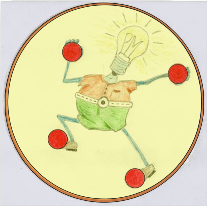
Der Durchbruch
Das Prinzip
Das Abroll-System
Das Zahnrad-System
Das Scheren-System
Das Stampfwerk
Soll ich mich schämen?
Die Software-Ratsche
autonom?
Impulsaustausch
Motus als Getriebe
Motus + Pendel
Motus + Satellit
Das Primum movens
Das Unwuchtsystem
Die Geheimnisse ..
Wenn ein Pfund ..
Das Kreuz
Der Drehpunkt
Das Kreuz im Rad
the momentous 13
my solution
the camshaft
geneva drive
... even more sites
in 2022
..back to startpage

© 2021 by Alois Zimmermann | Kontakt | Impressum | Updates | Ausblick |
The stampers as clock and pulse generator back to german
What does the camshaft actually do in a four-stroke engine?
It controls the valves depending on the position of the crankshaft.
In the Besslerwheel processes have to be controlled very exactly too,
e.g. the movement of the flying weights. Was this managed internally
at all by pendulums, springs or something like this? No!
Bessler had a much better, an ingenious idea for it:
the stampers.
They are part of the „mystery in the axle”, but are not recognized
as it because not hidden. The really brilliant thing however is, that it takes over
control but also brings along the power for the operations to be initiated.
At the same time it probably belongs to the mysterious thing which Bessler
calls the „primus motus”.
Principle of the control and force transmission is shown in the sketch
but the exact mechanics are to be found.
 |
The picture shows the well-known wheel with the 13 rest points at the rim
and the slightly offseted unbalanced cross with four flying weights.
This scene requires two stampers which always were double-acting at Bessler
and thus generate four pulses per revolution.
The wheel turns clockwise and because of its mass it has a certain inertia.
The pin protruding from the axle engages the notch of the stamper at the
appropriate time and is intended to lift it.
But since a stamper has a considerable weight - approx. 25 kg at the big
wheels - the pin first twists slightly downwards. This little rotation is
transferred inside the axle to a lever, which swings out the corresponding
flyweight by rope pull. The large force shock that occurs as a reaction
when the stamper is accelerated is ideally suited to start the movement of
the flyweights.
See also MT13: „...or someone would be around to lift up the
weight at D on top always like lightning”.
Even though the force impact rapidly loses energy, the work is done
and it is still enough to prevent a fall back, even more the centrifugal
force is helping quickly.
Imbalance is thus built up again, torque goes into the inertia of the
wheel and so this can lift up the next stamper and even deliver
additional work.
But how exactly does the lifting of the stampers work?
A stamper will usually stand on the ground in such a way that the pin is
not yet completely horizontal when it is engaged. The angle will be
between -30 and -10 degrees (left picture). The exit angle above has to
be larger, about +30 to +50 degrees. To lift a stamper, the axle will
rotate 60 degrees and more. The angle will be even larger if the initial
torsion is taken into account.
 |
When constructing the axle with lifting pins, it is noticeable that
the radius to the tip of the pin and the height of fall are
approximately the same. Here with a lower angle of -25 and an upper
angle of +42 degrees. In the picture: - radius axle = 11 cm - radius tip of pin = 15 cm - height of fall = 15 cm |
Here is a short explanation concerning the stampers of the several wheels:
From the last two wheels Bessler left some copper engravings, after that the
third wheel had four stampers and produced eight pulses per revolution.
The fourth wheel had two stampers and an archimedean screw (pump) with a square
drive wheel. Four strong and four weak pulses were probably generated here.
According to Gottfried Teuber, the second wheel had three stampers and thus
achieved six pulses per revolution. Very little is known of the first wheel,
but most likely it also had three stampers.
Whether a pin is engaged every 45 or every 60 degrees, generally there will be two overlapping lifts. An exception probably was the fourth wheel. Here, so-called lifting battens were interposed, which possibly acted as a kind of spring and could extend the impulse. The pulses of the stampers probably had to be amplified to compensate for the weaker ones in between.
In the following table the four wheels are listed with speed, cycle
time (from one lift to the next), time of fall and height of fall i
estimate.
diameter and stampers / pulses per revolution
/ rpm / turnaround time / clock / time of fall / height of fall
 |
Bessler purposefully developed according to the requirements of his time:
The first smaller wheels had a high speed. Today that would be good,
but back then no one really could use it, e.g. as a roast turner or
to pull up goods. Consequently his development goals were:
The wheels should slow down, develop more power, be able to run
water games and become bidirectional.
Bessler has been able to achieve
all these things in the shortest time possible.
Simply brilliant.